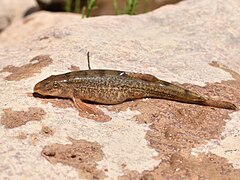Paralongicollum
| Paralongicollum | |
|---|---|
| Scientific classification | |
| Domain: | Eukaryota |
| Kingdom: | Animalia |
| Phylum: | Acanthocephala |
| Class: | Palaeacanthocephala |
| Order: | Echinorhynchida |
| Family: | Pomphorhynchidae |
| Genus: | Paralongicollum Amin, Bauer & Sidorov, 1991[1] |
Paralongicollum is a genus in Acanthocephala, the thorny-headed worms, also known as spiny-headed worms.
Taxonomy[edit]
The genus was described by Amin, Bauer & Sidorov, 1991. The National Center for Biotechnology Information does not indicate that any phylogenetic analysis has been published on any Paralongicollum species that would confirm its position as a unique order in the family Pomphorhynchidae.[2]
Description[edit]
Paralongicollum species consist of a proboscis covered in hooks and a trunk.
Species[edit]
The genus Paralongicollum contains three species.
- Paralongicollum edmondsi (Golvan, 1969)[a][3]
- Paralongicollum nemacheili Amin, Bauer & Sidorov, 1991[1]
- Paralongicollum sergenti (Choquette & Gayot, 1952)[b][4]
Distribution[edit]
The distribution of Paralongicollum is determined by that of its hosts.[5]
Hosts[edit]

The life cycle of an acanthocephalan consists of three stages beginning when an infective acanthor (development of an egg) is released from the intestines of the definitive host and then ingested by an arthropod, the intermediate host. Although the intermediate hosts of Paralongicollum are arthropods. When the acanthor molts, the second stage called the acanthella begins. This stage involves penetrating the wall of the mesenteron or the intestine of the intermediate host and growing. The final stage is the infective cystacanth which is the larval or juvenile state of an Acanthocephalan, differing from the adult only in size and stage of sexual development. The cystacanths within the intermediate hosts are consumed by the definitive host, usually attaching to the walls of the intestines, and as adults they reproduce sexually in the intestines. The acanthor is passed in the feces of the definitive host and the cycle repeats. There may be paratenic hosts (hosts where parasites infest but do not undergo larval development or sexual reproduction) for Paralongicollum.[8]
Paralongicollum parasitizes animals. There are no reported cases of Paralongicollum infesting humans in the English language medical literature.[7] P. sergenti might be a vector for another parasite in humans.[9]
- Hosts for Paralongicollum species
-
The Rainbow trout is a host for P. nemacheili.
-
The Tibetan stone loach is a host for P. nemacheili.
Notes[edit]
- ^ A binomial authority in parentheses indicates that the species was originally described in a genus other than Paralongicollum . It was originally described as Longicollum edmondsi by Golvan in 1969 before taking its current name in 2022 by Smales.[3]
- ^ A binomial authority in parentheses indicates that the species was originally described in a genus other than Paralongicollum . It was originally described as Tenuiproboscis sergenti by Choquette and Gayot in 1952 and then renamed to Longicollum sergenti by Golvan in 1969 before taking its current name in 1991 by Amin, Bauer & Sidorov, 1991[1]
- ^ There are no known aberrant human infections for Paralongicollum species.[7]
References[edit]
- ^ a b c Amin OM, Bauer ON, Sidorov EG. The description of Paralongicollum nemacheili n. gen., n. sp. (Acanthocephala: Pomphorhynchidae) from freshwater fishes in Kazakh S.S.R. J Parasitol. 1991 Feb;77(1):26-31. PMID: 1992092.
- ^ Schoch, Conrad L; Ciufo, Stacy; Domrachev, Mikhail; Hotton, Carol L; Kannan, Sivakumar; Khovanskaya, Rogneda; Leipe, Detlef; Mcveigh, Richard; O’Neill, Kathleen; Robbertse, Barbara; Sharma, Shobha; Soussov, Vladimir; Sullivan, John P; Sun, Lu; Turner, Seán; Karsch-Mizrachi, Ilene (2020). "NCBI Taxonomy: a comprehensive update on curation, resources and tools". Taxonomy Browser. NCBI. Retrieved 1 April 2024.
- ^ a b Smales LR. An Evaluation of the Genera Longicollum and Paralongicollum (Pomphorhynchidae: Acanthocephala) in Australia. Acta Parasitol. 2022 Sep;67(3):1230-1236. doi: 10.1007/s11686-022-00565-x. Epub 2022 May 26. PMID: 35616830.
- ^ Choquette, L. P. E.; Gayot, G. (1952). Tenuiproboscis sergenti nov. sp., acanthocephale trouve chez le chien a Alger. Archives de l'Institut Pasteur d'Algerie. 30: 51-54.
- ^ Smales LR. An Evaluation of the Genera Longicollum and Paralongicollum (Pomphorhynchidae: Acanthocephala) in Australia. Acta Parasitol. 2022 Sep;67(3):1230-1236. doi: 10.1007/s11686-022-00565-x. Epub 2022 May 26. PMID: 35616830.
- ^ CDC’s Division of Parasitic Diseases and Malaria (11 April 2019). "Acanthocephaliasis". www.cdc.gov. Center for Disease Control. Archived from the original on 8 June 2023. Retrieved 17 July 2023.
- ^ a b Mathison, BA; et al. (2021). "Human Acanthocephaliasis: a Thorn in the Side of Parasite Diagnostics". J Clin Microbiol. 59 (11): e02691-20. doi:10.1128/JCM.02691-20. PMC 8525584. PMID 34076470.
- ^ Schmidt, G.D. (1985). "Development and life cycles". In Crompton, D.W.T.; Nickol, B.B. (eds.). Biology of the Acanthocephala (PDF). Cambridge: Cambridge Univ. Press. pp. 273–305. Archived (PDF) from the original on 22 July 2023. Retrieved 16 July 2023.
- ^ Amane M, El Mazini S, Echchakery M, Hafidi M, Lemrani M, Boussaa S. Entomological, parasitological and molecular investigations in a new focus of cutaneous leishmaniasis in Youssoufia region, Morocco. Zoonoses Public Health. 2024 May;71(3):248-257. doi: 10.1111/zph.13105. Epub 2023 Dec 17. PMID: 38105536.


